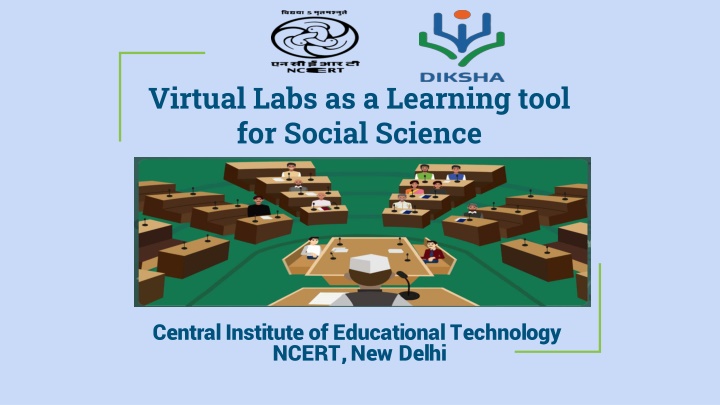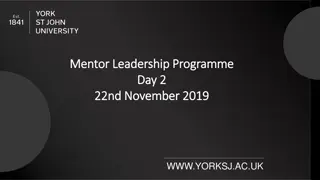
Enhancing Learning Through Virtual Labs in Social Sciences
Explore the integration of virtual labs in social science education as a tool to bridge the gap between theory and practice, enhance engagement and interest, provide safe and cost-effective learning experiences, and improve assessment and feedback mechanisms.
Download Presentation

Please find below an Image/Link to download the presentation.
The content on the website is provided AS IS for your information and personal use only. It may not be sold, licensed, or shared on other websites without obtaining consent from the author. If you encounter any issues during the download, it is possible that the publisher has removed the file from their server.
You are allowed to download the files provided on this website for personal or commercial use, subject to the condition that they are used lawfully. All files are the property of their respective owners.
The content on the website is provided AS IS for your information and personal use only. It may not be sold, licensed, or shared on other websites without obtaining consent from the author.
E N D
Presentation Transcript
Virtual Labs as a Learning tool for Social Science Central Institute of Educational Technology NCERT, New Delhi
NEP 2020 Technological Thrust Areas Enhancing Educational Access Increasing Access for Divyang students Teaching-Learning, Evaluation Supporting Teacher preparation & Professional Development Removing Language Barriers Streamlining Educational Management and Administration
Policy Perspective (NEP 2020 vision) Technology use and Integration Ensuring Equitable use of technology Extensive Use of technology in teaching and learning Content Creation, digital repository and Dissemination Blended mode of learning Addressing digital divide
Recommendation of NEP 2020 Ensuring Equitable Access to Practical Learning Every student should have access to high-quality, hands-on, and experiment-based learning experiences to strengthen conceptual understanding. Integration of Virtual Labs Virtual laboratories should be used to complement and enhance traditional lab experiences, making practical learning more accessible, especially in remote and resource-limited settings. Development of Lab-Based E-Resources Digital resources should be developed to help students visualize complex concepts, reinforcing theoretical knowledge through immersive and engaging interactives.
Policy Perspective (NEP 2020 vision) and Virtual Labs Experiential Learning - Virtual labs offer hands-on, interactive experiences that promote activity- based learning, making abstract concepts more engaging, tangible, and easier to comprehend. Integration of learning competencies - By utilizing digital tools, virtual labs enable personalized and adaptive learning experiences, fostering the development of essential competencies in the subjects of social science through interactive and immersive methods. Equity and Accessibility - Virtual labs bridge the digital divide by providing high-quality educational resources to students from diverse backgrounds, including those in remote and underserved areas, ensuring inclusive and equitable learning opportunities.
Virtual Labs in Social Sciences Bridging the Gap Between Theory and Practice: provide interactive experiences that bring these concepts to life. Enhancing Engagement and Interest: Simulations, virtual tours, and interactive exercises make subjects like history, geography, and economics more engaging. Safe and Cost-Effective Learning:risk-free and cost-effective way to study natural disasters, urban planning, or market simulations. Improving Assessment and Feedback Mechanisms:interactive quizzes, real-time feedback, and scenario-based problem-solving, ensuring that students grasp concepts effectively.
Need and Scope of Virtual Labs Concept of Virtual Labs- Virtual labs are simulated environments that allow students to explore social science concepts interactively, enhancing understanding through interactive methods. Educational Objectives- The primary purpose of virtual labs is to provide a safe, flexible, and engaging platform for students to learn social science concepts, fostering critical thinking and problem- solving skills. Integration with Curriculum- Virtual labs serve as a complementary tool in social science education, aligning with curriculum standards to facilitate deeper learning experiences and promote student engagement.
Advantages of Virtual labs Availability and Cost-Effectiveness Virtual labs can be accessed anytime, anywhere with an internet connection. They reduce the need for physical equipment, materials, and maintenance, making them a budget-friendly solution. Enhanced Engagement Interactive and immersive experiences in virtual labs make social science concepts easier to understand and more enjoyable to learn. Immediate Feedback Students receive real-time feedback on their performance, helping them identify mistakes, reinforce learning, and develop self-directed learning skills. Safe Exploration Virtual labs provide a free environment for students to explore social science concept and understand the concept through fostering creativity and innovation.
Virtual labs help learners in following ways Case Studies & Best Practices: - Virtual Heritage Labs for historical site reconstructions, GIS-based mapping for geographical concepts and Digital simulations Revisit, retry and review social science interactive concepts for better understanding. Experiential Learning: Virtual reality-based heritage tours allow students to walk through ancient civilizations. Climate simulations help students visualize the impact of global warming, deforestation, and natural disasters. Role-playing civic institutions enables students to simulate elections, policy-making, and legislative debates.
Pedagogical Integration of Virtual labs Increased Engagement Immersive and interactive virtual experiences enhance student motivation, making learning more engaging and enjoyable. Improved Retention Hands-on, experiment-based learning in virtual environments fosters deeper conceptual understanding, leading to better knowledge retention. Personalized Learning Virtual labs allow students to learn at their own pace, adapt simulations to their individual needs, and cater to diverse learning styles for a more effective educational experience. Enhanced Collaboration Digital learning environments promote collaborative learning, enabling students to work together, share insights, and develop problem-solving skills through teamwork.
Virtual Labs help teachers in following ways Design lesson/instructional plans incorporating Virtual Labs. Case Studies & Best Practices: Virtual Heritage Labs for historical site reconstructions, GIS-based mapping for geographical concepts and Digital simulations of economic theories in NCERT Economics textbooks. Leverage Virtual Labs for Online and Blended Classrooms and allows student to participate in practical activities from anywhere. Integrate virtual labs into assessments, to evaluate students practical understanding of concepts through interactive simulations and activities. Enhanced Engagement: Students interact with historical and geographical data dynamically rather than relying solely on rote memorization.
Steps to reach at desirable resources of Virtual labs URL: https://diksha.gov.in/
Virtual Labs in DIKSHA Step 1: Search https://diksha.gov.in/ Step 2: Scroll banners to find Virtual Labs vertical and click on its Explore icon. Step 3: Scroll down on the landing page of Virtual labs to reach eContent of class 6. Step 4: Click on the Explore icon of the class 6, select the English medium, then choose a Social Science as subject. Step 5: Click on the Explanation resource to reach the link for related resources
Scroll banners to find Virtual labs vertical and click on its Explore icon.
Scroll down on the landing page of Virtual labs to reach eContent of classes 6-12.
Click on the Explore icon of the desirable class, select the medium of interaction, then choose a subject mathematics






















